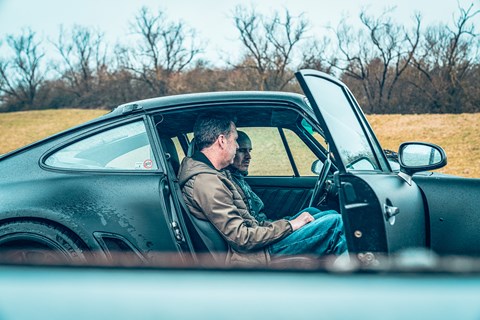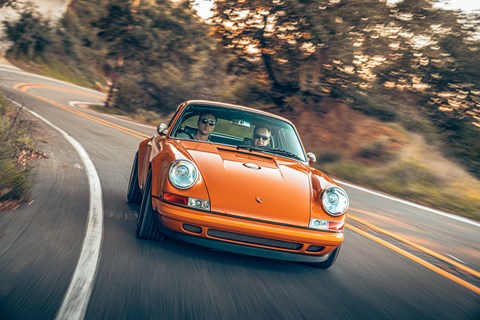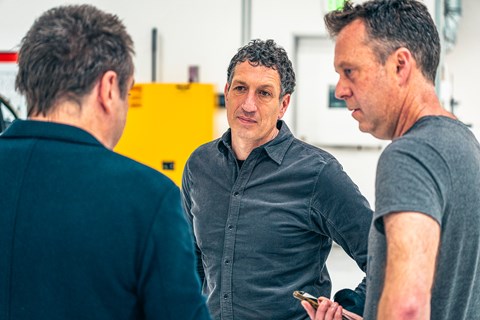► A deep dive into Singer Vehicle Design
► We visit HQ in the US and UK operations
► Plus a ride in prototype Turbo and DLS Turbo
A decade ago, Singer founder Rob Dickinson considered winding up the business he’d built ‘reimagining’ classic Porsche 911s. ‘We’d done 13 or 14 cars, people were saying nice things and clients knew they were proper. But orders were trickling in, they were ferociously expensive cars to re- store and we were losing money on every single one of them,’ he reveals. ‘In 2014 or 2015 I said, “Right, why don’t we give up?”’
Thankfully Dickinson did not give up. In fact, in the decade since, he’s doubled down, notably bringing Maz Fawaz onboard as CEO – a tech entrepreneur who ‘turned up in the car park in 2010 with a very good 993 RS replica, pretending to be a customer’. Together they’ve grown the workforce from seven people to 620 while dramatically expanding Singer’s footprint and customer base.
Today Singer has restored and upgraded more than 380 911s, which now typically cost from $900k (£700k) plus the original car and taxes, with 150 of these completed in the last year alone. It has operations in California and the UK, and runs development programmes to TÜV standards in collaboration with OEM royalty; Michelin, Bosch, Brembo and Mahle.

A damp February day in England. Shutters rise on an industrial unit at Millbrook proving ground. Inside sit the cars being used to test the results of the Turbo and Singer DLS Turbo Studies for clients – a glimpse of Singer’s next chapter and its first foray into the turbocharged Porsche era.
A large team mills around with bobble hats, laptops and coffees. Some are Singer’s own people, others represent those tier-one suppliers, while development driver and former 12 Hours of Sebring winner Marino Franchitti feeds back after his latest test run in the Turbo Study.

Yours for a little over $1m (£780k) depending on spec, and with 499 restorations expected, the Singer Turbo Study (the black car in these pictures is a Turbo Study prototype) caused a stir at Goodwood back in 2022, at that point already two years in the making and looking 100 per cent complete, but Singer’s quest for perfection continues.
Like the original 930 Turbo, Singer’s reinterpretation features a turbocharged air-cooled flat-six, manual gearbox and rear-wheel drive. It also gets the look – whaletail spoiler, moulded black rubber and all – but the muscle is exaggerated, the detail crisper, the fetishisation more overt. As Dickinson puts it: ‘Everything’s been touched, but at the same time it had to feel sincere to the original.’
Today’s Turbo Study is very much the test mule. There’s matte black paint, duct-taped sensors and mismatched seats. A ‘UK’ bootlid sticker attests to European test trips, and this hard-worked 911 drove all the way. ‘Just living with it like that reveals so much,’ says Franchitti. Someone suggests it’s done maybe 15,000 test miles. ‘Oh at least,’ he nods.
Where the Turbo Study is obviously a test car, the orange car, born from the DLS Turbo project (for Dynamics and Lightweighting Study) initially appears the finished article. It’s a serious bit of kit at a serious price – expect each of the 99 examples to cost around $3m.

Fat 20-inch rear Cup 2s fill radical box arches in deference to Porsche’s 934/5 racers of the ’70s, perfect orange paint brings the old Jägermeister cars to mind and there’s the most gorgeously finished interior of matte carbonfibre, exquisite leather and honeycomb orange fabrics.
Behind the seats, though, sits a bank of computers – there’s so much kit, the alternator belt audibly protests at the extra electrical load. Just like the previous ‘Classic’ and the DLS developed with help from Wil- liams (limited to 450 and 75 units respectively, now sold out) these new forced-induction machines are restored examples of the 964-generation 911 produced from 1989 to 1994 – the classic 911 shape but with more modern chassis engineering, runs the logic.
Franchitti’s task is to mould distinct personalities for these two projects and ensure everything hangs together as a cohesive whole. He in- vites me to jump into the Turbo Study’s passenger seat first.
Franchitti talks about selectively allowing more noise into the cabin to heighten drama, tweaking attributes with a mix of original engineering parts and bespoke components, and enthuses about ‘making something for everyone, and helping owners get more out of the cars than they expected’. It’s the kind of subjective stuff engineers talk about, not racers.

Franchitti says he wants to build on the Turbo’s stock attributes as a quick, luxurious grand tourer that can still entertain on the twisty stuff, while simultaneously making it more user-friendly and more predictable than the standard car. ‘These Porsches are incredibly sensitive on their trailing-arm suspension and short wheelbases, so being able to refresh all those parts and bring it together with new dampers and Michelins – it’s very satisfying. This car needs a bit more work on its secondary ride, though; you can feel it in your body.’
Like the chassis, this 964-era air-cooled engine should also significantly elevate the experience, stretching from the final G-Series Turbo’s 3.3 litres and 296bhp to 3.8 litres and 450-510bhp in a package around 30kg lighter at 1270kg.
This is no barely constrained racer, though – it’s chatty and characterful without being overbearing, trickles about happily at next to no revs and – when we go for a blast down Millbrook’s Mile Straight – builds boost progressively through to around 3000rpm before breaking into a forced induction sprint.
I comment that it seems manageable from the passenger seat, even in this wintry weather. ‘It’s about making sure that when it starts to boost you have complete control; it doesn’t push on and do anything to erode your confidence,’ Franchitti sums up.
Impressive as it is, I’m also very aware I’m sitting in a work in progress – the Singer magic isn’t quite there yet.
Yet a week or so earlier in LA, looking at early Turbo Studies in-build, I’d struggled to reconcile the knowledge that these cars have already lived a life with the perfection before me – bodyshells that have been stripped, media-blasted, rust-proofed and strengthened before being clothed in lightweight carbonfibre panels and the whole lot painted to a standard the originals could only dream of.
This 115,000 square-foot Torrance facility has been Singer’s home since 2022, allowing it to pull together in one workshop operations previously scattered over seven. ‘We were able to go through our tick list of things that make our lives incredibly difficult and solve those problems,’ says Dickinson. ‘Paint getting chipped, cars going back for repair, getting damaged again – it was absolute torture,’ he admits.

The scale is like nothing I’ve seen in the restoration space – cars with paint you could almost dive into line up on dollies row after row, each carefully positioned on floor markings like automotive Subbuteo.
Bright strip lights are reflected in a spotless white floor, Fawaz shows me round paint booths that took forever to get through California’s strict legislation, plus bustling metal-working areas, an upholstery shop where craftspeople can stitch a three-spoke steering wheel with a single piece of thread, and leather trim samples from which buyers can request just about anything – one particularly challenging commission demanded all the colours of a sunset.

On an otherwise naked white wall is a reminder that ‘everything is important’ – Dickinson had tired of writing notes on work that was important and could be improved, before one day scrawling ‘everything is important’ in exasperation. Today it’s a mantra.
I’m excited to meet Dickinson. As frontman – or‘singer’ – of ’90s alternative band Catherine Wheel, his music was embedded in my teenage soundtrack. That part of his story is well known. Perhaps less well known is that the one-time Norfolk native studied industrial and trans- port design at Coventry University, and started his career at Lotus.

Dickinson: ‘Peter Stevens hired me in the late ’80s. I was still at college, I wanted to take a year off to pursue music but my parents insisted I got a job, so I ended up at Lotus surrounded by fantastic talent; Simon Cox, Julian Thomson, Andy Harris…’
Catherine Wheel’s success saw Dickinson pivot full-time to music, but he describes a crossroads in the mid-noughties – a sense of music leaving him as an obsession and the idea of his perfect 911 taking over.
‘I moved to New York in 2001 to make my own record, then to Los Angeles in 2003, and that’s when I came up with my perfect 911,’ he explains. ‘So, from 2003 to 2006, this idea of a Frankenstein 911 started to mutate, with an appeal that went deeper than just the 911 nerds like me. Driving around Los Angeles, people wanted to talk about the car and to buy it. I stopped saying “no” and started saying, “I can do something even better”.’
Ex-Lotus colleague Andy Harris visiting Dickinson in an LA dressing room in 2006 provided the catalyst.
‘Andy had since worked at Vector and other low-volume companies and told me that if I ever wanted to do anything with cars or design in Los Angeles, he knew everybody: the prototyping people, the carbon people… And suddenly the road blocks between me and creating what I thought was the perfect 911 started to break down, this vista opened up and I thought, “f**k me – we’re going to do it”,’ remembers Dickinson.
Progress since has been remarkable. From Dickinson requiring two carpal tunnel surgeries because he was so hands-on with restoration work, to the step-change of OEM-style development processes in collab- oration with Williams Advanced Engineering on 2018’s Dynamics and Lightweighting Study, to the strategic nous of Fawaz, who has grasped the business side of things ‘that made me miserable’.
There is now a sense of order missing in Singer’s earlier days – a whiteboard plots its moves through the next six months and, behind the scenes, a ‘Next Decade’ strategy arranges chess pieces far beyond.

Today for me, though, it’s a chance to experience the car that started it all – the Classic. It’s the first Singer-restored 911 I’ve driven.
Much as this car looks sublime, the revelation is how incredibly well it goes down a road. Dubbed ‘the Hollywood Commission’ and inspired by Dickinson’s original 1969 911e Brown Bomber, it features carbonfibre bodywork in Bahama Yellow, lightweight carbonfibre sports seats trimmed in Andes Green leather and Fuchs wheels – comparatively slender with generous negative camber on the front axle, dished like hamster wheels on the rear to fill swollen arches.

I spend an afternoon carving up a canyon road north of Santa Monica, smitten by the balance of supple compliance with absolute control, how it flows over this tricky surface where you’d forgive those wide tyres and its lowered suspension for fussing and snatching like a hound.
With 390bhp, the 4.0-litre flat-six makes easy meat of the 1250kg or so it has to lug. I love how eagerly it pulls from low down, then rasps and sings as the needle on the ‘Screaming Rob’ tacho whips round past 7000rpm, and how the next gear slices home more sweetly than in any air-cooled 911 I’ve experienced. You can lean on the front end in a way just can’t in an old 911, then use all that power to get the rear working on corner-exit.

Classic 911 traits and idiosyncrasies absolutely live on but this is something altogether different – tauter, faster, more confidence-inspiring, like all the slack’s between extracted, the chasm closed between how you’d hope an old 911 would drive and the reality.
Yes, you could get a genuine 911 2.7 RS for less. But the truth is this is vastly better. By the time we stop for fish and chips to watch sundown over the Pacific coast, I’ve connected with the Hollywood Commission so completely that – agonisingly – it feels like my car.

The Classic Study ultimately led Singer to the DLS, to date the peak of its naturally-aspirated endeavours, with a Williams-engineered flat-six that runs all the way to 9300rpm. Now DLS, in turn, begets DLS Turbo.
Back at Millbrook on that damp February Friday, Franchitti invites me to take a seat in the orange and unexpectedly pristine test DLS Turbo, apologising that I must balance an essential and really quite toasty laptop on my knees.
He flicks the digital instrument binnacle to his preferred screen and, as he depresses the clutch, chatter from the single-mass flywheel quietens. The gear mechanism has a gorgeous exposed structure, like a cyborg’s skeleton visible through torn sinew. I watch the mechanism mirroring Franchitti’s input as he slots first. Revs up and we’re away.
Appropriately given its visual aggression and racecar inspiration, the DLS Turbo is a significantly more visceral experience than the Turbo.
This chassis set-up is an evolution of the DLS’s, notably EXE-TC dampers and front suspension with an upper wishbone and lower multi-link design, and it stays spirit-level flat and bites hard when Franchitti carves it over Millbrook’s sodden sweepers.
It’s an angry thing, and from where I’m sitting it feels closer to some- thing like a 993 GT2, just with a load more kick and attitude – exciting as hell but not the best pick for a road trip.
Much remains to be done, but really this particular car is all about engine development. More HG Wells than Hans Mezger when you look under the engine lid, the 3.8-litre flat six produces around 700bhp, revs to nine grand and – like the naturally-aspirated DLS restorations – features four-valve heads. This time, though, they’re liquid-cooled while the block remains air-cooled, just like the 959.
Franchitti says it’s essentially naturally-aspirated for 75 per cent of throttle travel, the turbochargers coming to the fore in the remainder.
‘Right now it’s all about the correlation between what we’ve seen on the dyno and what we’re seeing as we start to run the car. It’s about the building blocks, gathering tonnes of data and starting to build the driva- bility of the engine, not rushing ahead,’ he explains.
Even so, boost kicks like a rocket and releases its energy with a whip-crack every time he shifts gear – it is wickedly, violently addictive, kind of euphoric even. We just look at each other and laugh.
Like the Turbo Study, these restorations will feature traction control and ABS and must be exploitable for mere mortals. But the DLS-T also has to be more challenging to drive than its sibling, it’s part of the point. Franchitti hopes it’ll burn with an analogue intensity comparable to that of Ferrari’s F40.
It all begs the question: where does Singer go from here? Back in LA, I’m assured there’ll be another naturally-aspirated 911 at some point, and I hear intriguing references to other non-911s from earlier in Porsche’s catalogue, as well as the idea of ‘celebrating’ post-964 cars in the future.
Beyond the cars, Singer has started to position itself as a luxury brand. It plans to produce 200 Swiss watches priced from $25k-$90k in 2024, there are investors with ‘robust financing’ and stats to say sales increased by 225 per cent over the past three years, which may well attract more investors. The company is looking to expand into Japan, mainland Europe and the Middle East.

Fawaz projects that Singer will settle at restoring around 200 cars annually, with staff numbers around 700. After all, he says, order books are full through to 2027. They need to crack on.

Ten years since Dickinson almost gave up, it looks like Singer’s founder, Fawaz and about 618 other people have discovered not only their voice, but a highly appreciative audience.